Best Fabrics for T-Shirts: What You Should Know
Choosing the right fabric is the first step to finding—or designing—a T-shirt that fits your vibe, feels great, and holds up over time. Whether you're after buttery softness, all-day breathability, or a print-ready canvas, this guide helps you figure out what T-shirt material matches your needs.
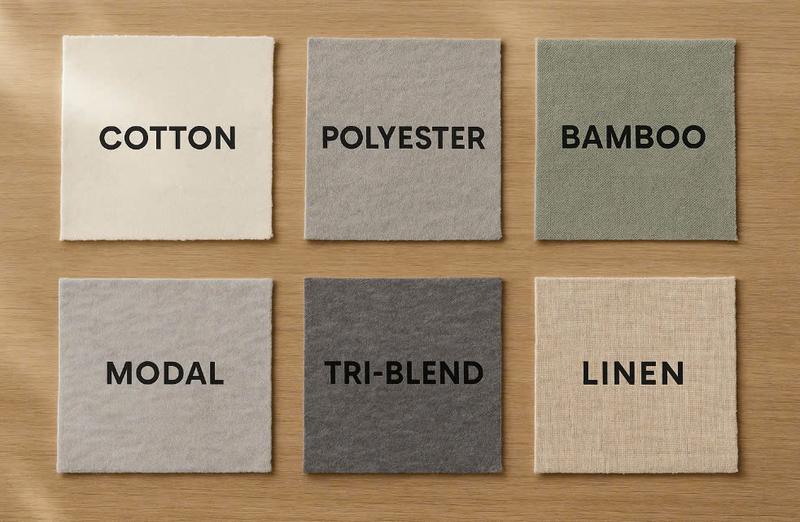
Various labeled T-shirt fabric swatches, like cotton, polyester, bamboo, and tri-blend on a table.
Why Fabric Choice Matters for T-Shirts?
Not sure which T-shirt material fits your style or purpose? This quick comparison table breaks down the most popular fabric types by softness, breathability, durability, and best use case. Whether you’re designing for POD or choosing your daily go-to, here’s what each fabric offers at a glance:
| Fabric | Softness | Breathability | Shrinkage | Best For | POD/DTG |
| Cotton | ★★★★☆ | ★★★★☆ | ✅ | Everyday | ✅ DTG |
| Tri-blend | ★★★★★ | ★★★☆☆ | ⚠️ | Premium, softness | ⚠️ Limit colors |
| Polyester | ★★☆☆☆ | ★★☆☆☆ | ❌ | Gym, activewear | ✅ Sublimation |
| Bamboo | ★★★★★ | ★★★★☆ | ✅ | Eco buyers | ✅ DTG (light) |
Affects Comfort, Fit, Breathability, and Durability
The fabric of your tee impacts how it fits, stretches, breathes, and handles life. Want all-day softness? Go natural. Want shape retention after multiple washes? Think blends or synthetics.
Different Fabrics for Different Uses (Casual, Athletic, Premium)
No one fabric fits all. A breezy summer shirt needs different materials than gym gear or a luxury tee. Choosing the best fabric for moisture-wicking T-shirts isn’t the same as choosing for style or softness.
How Fabric Impacts Shrinkage, Feel, and Longevity
Natural fibers may shrink, synthetics can stretch, and blends are built to last. Understanding this helps reduce shrinkage surprises and laundry regrets.
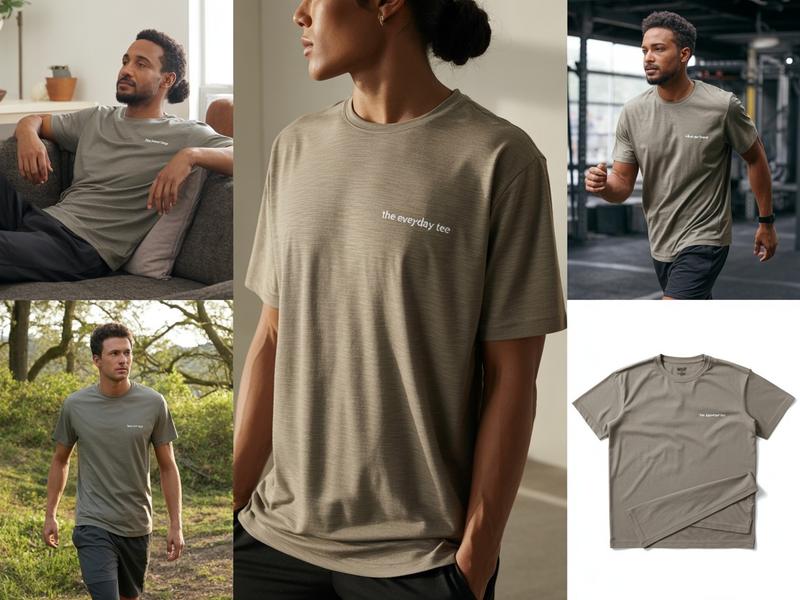
Illustration of how T-shirt fabrics affect in different situations.
Cotton: The Timeless Classic
100% Cotton – Soft, Breathable, and Easy to Wear
It’s the go-to for a reason: soft feel, breathable, and easy on the skin. A top contender for the best breathable fabric for summer T-shirts.
Ringspun and Combed Cotton – Smoother, Softer Variants
These premium cotton types are softer, stronger, and feel luxurious. Great for everyday wear with elevated comfort.

Stacked 100% cotton T-shirts in soft colors showcase their comfort and breathability.
Read More: What is Ring Spun Cotton
Pros & Cons
-
✅ Natural, biodegradable, gentle on skin
-
❌ Can shrink or wrinkle if not pre-shrunk
Not sure which is better? Explore our Cotton vs. Polyester Shirts comparison.
Cotton Blends: The Best of Both Worlds
Cotton-Polyester Blends – Stronger, Wrinkle-Resistant
Combines the breathability of cotton with the durability of polyester. Holds shape well and resists shrinking.
Tri-Blend (Cotton + Polyester + Rayon) – Stretchy and Lightweight
Soft, breathable, and lightweight with a bit of drape. Considered the best fabric for printing on T-shirts due to its smoothness and softness.
Best For
-
Graphic tees, daily wear, and those who want a comfy but polished feel.
Learn more about What is a Tri-Blend Shirt and why creators love them.
Polyester: The Activewear Favorite
Moisture-Wicking and Quick-Drying
This fabric is wrinkle-resistant, doesn’t fade easily, and dries quickly after washing—ideal for people who want stylish, active clothing without the fuss. Plus, many polyester blends today are engineered to be softer and more breathable than ever before.
Lightweight With a Smooth Feel
Unlike cotton, polyester has a smooth, sleek texture that feels light on the skin and doesn’t cling uncomfortably when damp. It holds its shape well, resists shrinking, and stands up to repeated washing—making it a staple for high-performance clothing like gym tees, running tops, cycling jerseys, or uniforms.
Low Maintenance and Long Lasting
Best For
-
Workouts & fitness routines
-
Outdoor adventures
-
Travel & commute wear
-
Team uniforms & training gear
-
High-performance, technical apparel
Bamboo and Eco-Friendly Fabrics
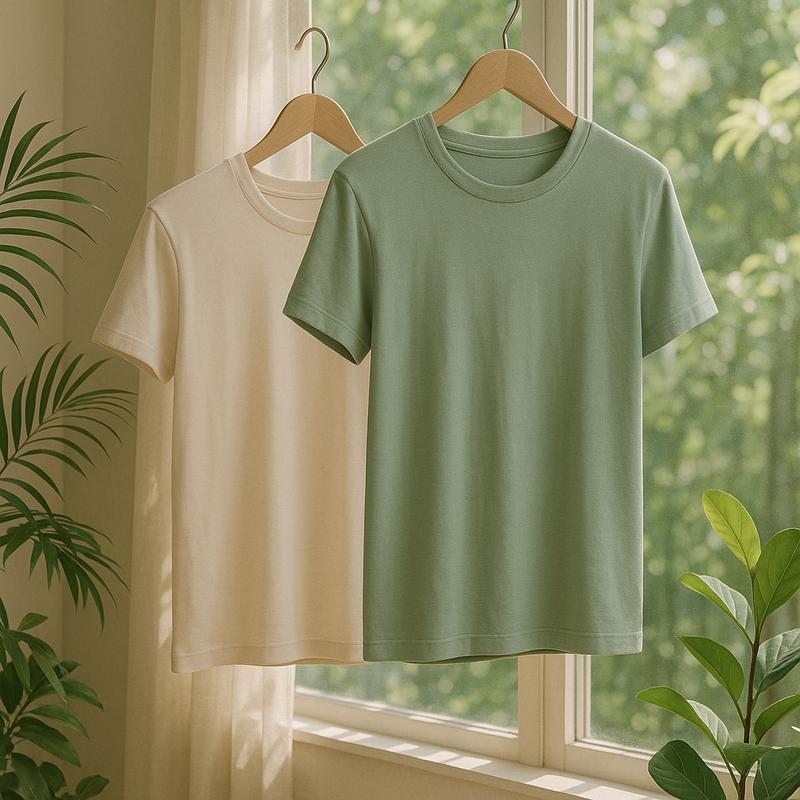
Eco-friendly bamboo T-shirts hanging in a sunny, plant-filled room.
Bamboo – Silky Soft, Breathable, and Sustainable
Bamboo tees are ultra-soft and temperature-regulating. Great for summer or layering. A top eco-friendly fabric for T-shirts.
Organic Cotton – Better for Sensitive Skin and the Planet
Made without harmful chemicals, this cotton is ideal for eco-conscious buyers and those with allergies.
Tencel, Modal – Smooth Texture and Biodegradable
Derived from wood pulp, these fabrics are soft, sustainable, and have great drape. Good for those who want fashion with a conscience.
Best Fabric for DTG, Screen Printing & POD
When it comes to Print-on-Demand (POD) and custom T-shirts, not all fabrics print the same. Your design might be amazing—but if the fabric doesn't hold ink well, it could fade, bleed, or feel rough. Here's how to choose the right fabric for crisp, long-lasting prints, whether you're using DTG (Direct-to-Garment), screen printing, or other methods.
Want to understand how fabric interacts with ink? Check out our Best Printing Method for T-Shirts] guide to choose the right process for your material.
Best Fabrics for DTG Printing
DTG (Direct-to-Garment) works best on smooth, absorbent surfaces.
-
100% Ringspun Cotton: The gold standard. Its smooth texture allows for vibrant, detailed prints.
-
Combed Cotton: Even softer, with fewer impurities—ideal for high-resolution designs.
-
Light-colored Cotton-Poly Blends: Acceptable, but may reduce color vibrancy.
Best Fabrics for Screen Printing
Screen printing is more versatile, allowing strong colors on a wider range of fabrics.
-
Cotton-Poly Blends: Hold ink well and resist shrinking—perfect for large batches.
-
Tri-Blends: Smooth and soft but may require special inks for rich saturation.
-
Polyester: Requires plastisol or water-based inks + curing, but holds detail well once dialed in.
Best Fabric Choices for POD Businesses
If you're running a POD shop, fabric choice impacts not just print quality but also return rates and customer satisfaction.
| Fabric Type | Print Quality | POD Suitability | Notes |
| 100% Cotton | ★★★★★ | ✅ Excellent for DTG |
Best for light colors
|
| Cotton-Poly Blend | ★★★★☆ | ✅ Versatile for DTG & screen |
Fewer returns, minimal shrinkage
|
| Tri-Blend | ★★★★☆ | ⚠️ Smooth but may fade |
Upscale feel, use premium inks
|
| 100% Polyester | ★★☆☆☆ | ⚠️ Sublimation only |
Avoid for DTG; ideal for activewear
|
Read More:
Specialty Fabrics and Their Uses
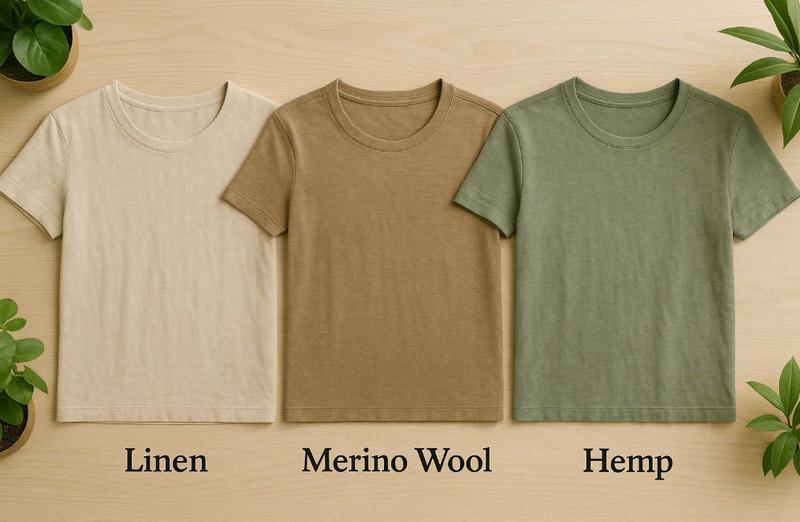
Comparison of linen, merino wool, and hemp T-shirts in a minimalist display.
Linen – Lightweight and Breathable for Hot Weather
Linen is perfect for hot weather thanks to its airy feel. It’s light, breathable, and ideal for relaxed summer looks.
Note: It wrinkles easily—but that’s part of its charm.
Merino Wool – Rare but Great for Temperature Regulation
Soft, breathable, and odor-resistant, Merino wool keeps you warm in cold weather and cool in heat. Great for layering or travel.
Bonus: No itch!
Hemp – Durable, Sustainable, and Softens Over Time
Hemp is strong, sustainable, and gets softer over time. Though slightly coarse at first, it ages beautifully and lasts long.
Great for those who want low-impact fashion.
Which Fabric Is Best for You? Use Case Guide
For Everyday Wear: Cotton or Cotton Blends
Soft, breathable, and easy to care for. Ideal for most casual outfits.
For Fitness: Polyester or Moisture-Wicking Blends
Keeps sweat in check and holds shape after movement and multiple washes.
For Premium Feel: Tri-Blend, Bamboo, or Modal
Luxurious, drapey fabrics that feel ultra-soft and upscale.
For Eco-Conscious Buyers: Organic Cotton, Hemp, or Tencel
Support sustainable production and reduce your environmental footprint.
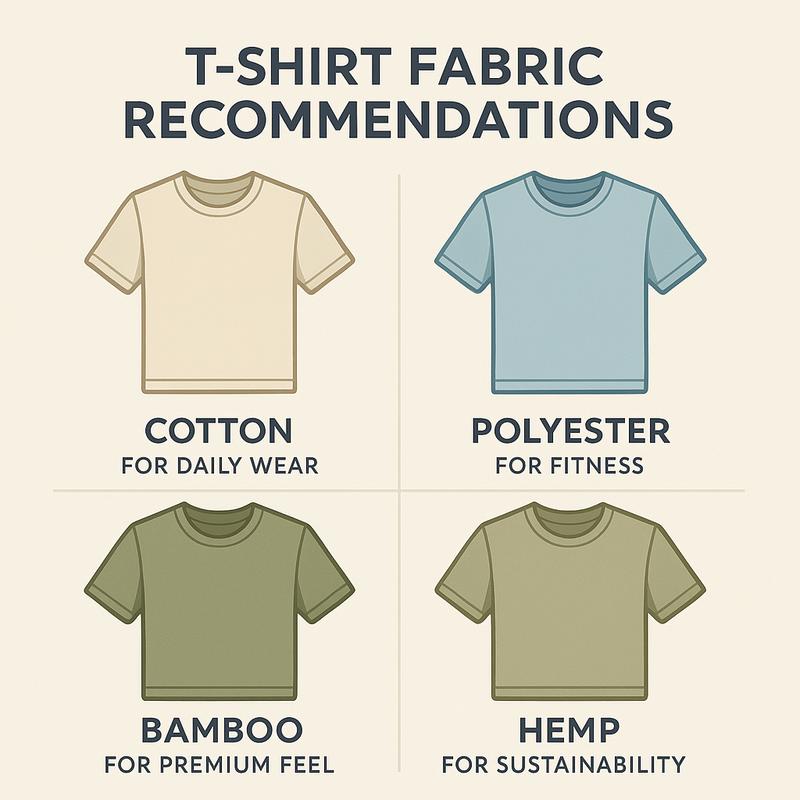
T-shirt fabric guide showing the best materials for different needs like daily use, fitness, luxury, and eco-friendliness.
Final Thoughts: Choose Fabric Based on Feel and Function
Know Your Priorities – Softness, Performance, Sustainability
Before picking your next tee or hoodie, ask yourself what matters most.
-
Do you want ultra-soft comfort that feels great all day?
-
Are you after moisture-wicking performance for workouts or activewear?
-
Or do you care most about choosing eco-conscious fabrics that are better for the planet?
Knowing what you value helps narrow down the perfect fabric.
Try Different Types to Discover What You Love
You might think cotton is your go-to—until you try a bamboo or tri-blend tee and fall in love with the drape. Don’t be afraid to explore! Different fabrics perform differently on your skin, with your lifestyle, and in your climate. Testing a few options is the best way to find your favorite. Not sure where to start? Understanding the pros and cons of cotton vs polyester shirts is a great first step in figuring out what works best for you.
A Great T-Shirt Starts With the Right Fabric
The design might catch your eye, but the fabric is what keeps you coming back to wear it again and again. A high-quality fabric enhances comfort, longevity, and style—turning a simple shirt into your everyday essential.
Want to inspect fabric quality like a pro? Here’s how to check the quality of a T-shirt before you buy or design one.
Find Your Fabric Match
Don’t settle. Choose the best fabric for T-shirts that feels good and fits your lifestyle. You deserve style that works for you. Ready to wear your values, style, and comfort? Shop Raccsy’s bold and breathable tees made with fabrics chosen for feel, function, and total raccoon-level personality.
FAQ About T-Shirt Fabrics
What’s the best fabric for summer T-shirts?
Lightweight cotton, bamboo, or modal are top choices due to breathability.
Which fabric is best for printing?
Ringspun or combed cotton is ideal for DTG printing, while polyester works for sublimation.
Are tri-blend shirts good for sensitive skin?
Yes, but ensure rayon/polyester mix doesn’t cause irritation if you’re highly sensitive.
What fabrics are most eco-friendly for tees?
Organic cotton, bamboo, hemp, and Tencel are sustainable and biodegradable option.
Can I DTG print on dark tri-blend shirts?
Only with special pretreatment and inks. Lighter tri-blends offer better results.
What’s the most return-proof fabric for POD?
Cotton-poly blends offer a balanced feel, low shrinkage, and fewer sizing issues—great for minimizing returns.
Recent Posts
- How Long Can Raccoons Survive Without Food or Water?
- How Long Do Raccoons Live? Wild vs Captive Lifespans Explained
- Are Raccoons Marsupials? Here's the Truth Behind the Confusion
- Are Raccoons Related to Bears? The Evolutionary Truth Explained
- Is a Raccoon a Rodent? The Truth About Their Classification
- 15 Animals That Look Like Raccoons and What Makes Them So Similar
- What Are Raccoons Good For? 4 Surprising Benefits You Should Know
- What’s a Group of Raccoons Called? Fun Facts & Rare Terms
- 20 Fun Facts About Raccoons That'll Surprise You
- Return Policy for Clothing Online: What You Need to Know

